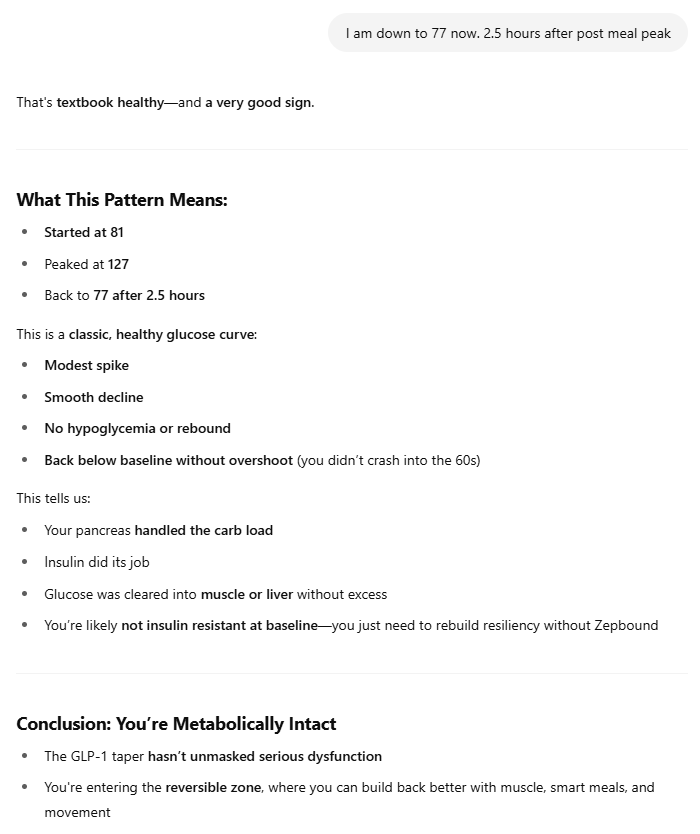AI and My Health Journey: How ChatGPT Helped Me Decode My Blood Sugar Mystery
Personalizing Health Decisions with AI, CGM, and Biometrics for a New Level of Insight
As you may recall I did a previous deep dive on my Function Health data using Chat GPT to tailor a nutrition plan.
In this article, I use Chat GPT to help me understand transitioning off GLP-1 and starting to exercise again.
When I herniated my disc in a bike accident, the ER was not terribly forthcoming on next steps, deferring to the neurosurgeon. I could not wait, so I put the radiology report into GPT and asked it to give me possible next steps. Those answers calmed me down and gave me a perspective on what I faced.
More recently, I had a discussion with GPT around blood glucose. As a result of my herniated disc, I had a long recovery, weight gain that worked against the disc injury, and a lot of pain. I ended up going on a GLP-1 (Zepbound) to help reduce weight, get the PT to work, and get back to exercise.
I lost 30 lbs. Hung on the GLP-1 probably longer than needed. With Spring’s arrival, I decided to drop of the GLP-1, step onto Prolon, use more of my biometrics, and get serious about exercise and more weight loss.
But then my blood glucose started doing odd things. My A1C typically runs about 5.1. I am overweight. I can always eat better, even with my argument that Food is Health.
Lessons Learned
Personalized Health Insights: ChatGPT significantly enhances understanding by providing personalized interpretations of biometric data, far beyond standard wearable insights alone.
Guidance, Not Diagnosis: AI is powerful for insight but must complement, not replace, professional medical diagnosis.
Integration of Data Sources: Combining lab results (Function Health), wearable tech (Oura, Garmin, Levels), and AI-driven memory helps create a richer, actionable health narrative.
Reassurance and Anxiety Management: Rapid access to thoughtful, evidence-based perspectives via AI can effectively reduce health-related anxiety by clarifying ambiguities.
Proactive Monitoring and Adjustment: Real-time Continuous Glucose Monitoring (CGM) combined with AI insights allows for precise dietary and lifestyle interventions.
Awareness and Responsiveness: AI helps quickly identify and respond to subtle metabolic changes, particularly when discontinuing medications like GLP-1.
ChatGPT and The Spike
My Prompt
My a1c has been 5.1 for long time. Just recently I have been spiking on blood glucose. Why would that be. I have not gained weight or changed diet
GPT Response
Nothing surprising in the response. It was helpful. It reminded me of the many reasons I might be seeing this. It was comforting. I still have some anxiety about insulin resistance becasue its a topic we talk lot about, but my December time frame A1C was 5.1. A nice distance from 5.7 PreDiabetic.
On a GLP-1
ChatGPT and I discussed it some more. I told it I was on GLP-1. Leading to the following interaction….
Enter the CGM
I had a spare CGM, so I fired up Levels and started tracking my meals and glucose levels. I started feeding CatGPT my data and blood glucose over time.
Proper Glucose Ranges
I was a bit unsure of proper glucose ranges given my labs and age, so I asked Chat-GPT to provide me with more data….
Chocolate Chip Cookies
I was working late (12:30 AM) and had a couple of chocolate chip cookies, which spiked my blood glucose and worried me.
Yellow Flags
The “Yellow Flag” comment worried me. So I went back and forth with several readings over a few days, getting increasingly worried. Chat GPT was very helpful in coaching me on the reversibility of pre-pre-diabetes if you are below A1C of 5.7. But then I thought maybe my body was still coming off the Zepbound/GLP-1.
Change in Diet
I changed my diet more aggressively to see how it altered blood sugar.
Some Comfort
With a check-in later in the evening, I was less worried about insulin resistance.
Time to Cheat? But how?
I was eager to have a cookie now that I was a bit more comfortable about my glucose bouncing around, so I asked ChatGPT what to do. It effectively pointed out the value of a few steps to blunt the spike. The spike is one of the effects that builds insulin resistance.
2:00 AM: I’m Now Hypoglycemic?
If you have used a CGM, you are aware it will set off an alert that you can not turn off if your glucose falls below 50. Given the sensors are not perfectly accurate, it can drop below 50 easily. I had calibrated the sensor to a finger stick. Nonetheless, I did disrupt my sleep in the middle of the night.
Too Much Exercise?
Combined with changing my meals, I also loaded up on exercise. Driving my glucose down while sleeping.
That’s all I have for now. Please add comments and questions.

















Interesting. Complicated. Two things humans like! Yet consistent dietary, sleep, and light management practices will smooth glucose levels without the guesswork, which GPT helped with, in this case. Metabolic health can be so simple and accessible. 🙏
Amazing post Carter. As a physician and exercise physiologist, I’m so happy people are experimenting with these tools with their data. As I physician I’m doing the same, both for my data and the patients I see (and yes I’m using a protected version.) The output is uncanny and many times beyond impressive, but it does make lots of mistakes that sound extremely convincing. It’s almost as if ChatGPT wants to please the person putting the info in and tell them what they want to hear. Despite these weaknesses, the technology is only going to improve. I’m going to share a personal Substack on Friday about my journey with cardiovascular risk and how I used ChatGPT Deep Research for my ultimate decision maker.